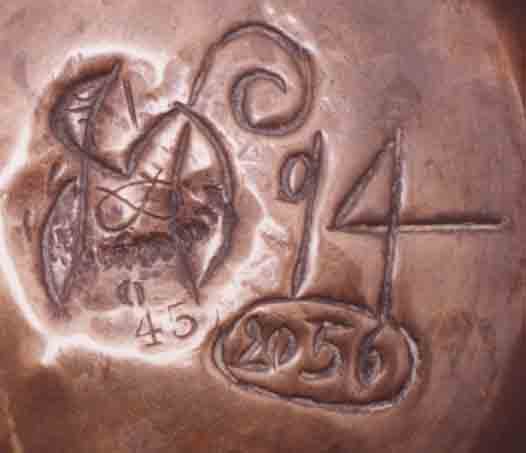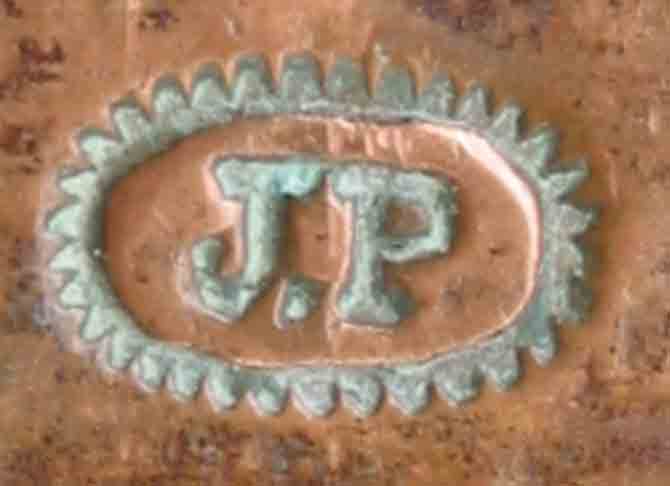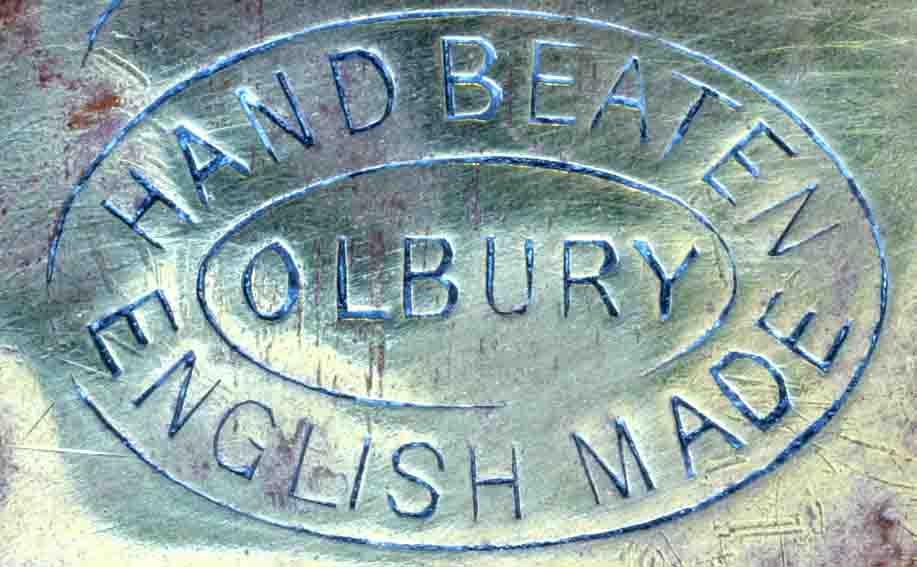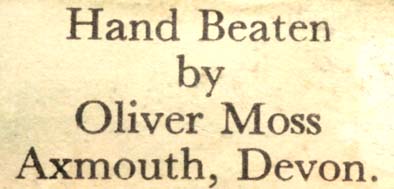Newlyn Copper
(c) Antique Metalware Society
Small extracts can be used with acknowledgements to 'Oldcopper.org' website.
Helpful comments are very welcome.
John D McKenzie founded the Newlyn Industrial Class in 1890. His idea was to provide an artistic centre of excellence in Newlyn, next to Penzance in Cornwall and not far from Lands  End. Employment would be available to fishermen during off-season times. He invited John Pearson to teach the class from 1892. Artists who worked there included Phillip Hodder, William P Wright, William Peezzack, Tom Batten, John Payne Cotton, Obed Nicholls, John Curnow, John Edgar Laity, George Mildren and Joe Pengelly. Production restarted after the war in 1920 under Tom Batten and Johnny Payne Cotton, lasting until the outbreak of WWII in 1939. It restarted in the 1950s with John Laity and Johnny Payne Cotton.
End. Employment would be available to fishermen during off-season times. He invited John Pearson to teach the class from 1892. Artists who worked there included Phillip Hodder, William P Wright, William Peezzack, Tom Batten, John Payne Cotton, Obed Nicholls, John Curnow, John Edgar Laity, George Mildren and Joe Pengelly. Production restarted after the war in 1920 under Tom Batten and Johnny Payne Cotton, lasting until the outbreak of WWII in 1939. It restarted in the 1950s with John Laity and Johnny Payne Cotton.

A variety of sizes of typeface were used for the marks. It is said that some of the output that was not marked at the time of production has subsequently been stamped. This may lead to 'new' looking stamp impressions. There are also forgeries about now. There is a display of works of the Newlyn School at Penlee House Museum, Penzance.

Mark of John Pearson, master coppersmith, together with the date. This is frequently found on his excellent repousée work. Early pieces were signed with a punch-point 'John Pearson' or 'J Pearson'. Some items were also marked with a pattern number. Others bore no mark.

This flowing 'JP' mark for 1894 and pattern number 2056 has been retrospectively scribed on the bottom of a tankard showing the remains of the Staffordshire Knot mark of J. Perry & Sons of Wolverhampton. The quality of the hammering was excellent and the item may well be genuine. The price being asked was ten times the value of the Perry Tankard used as the starter base for the craftsmanship.
 This mark is usually found on hammered trays of very simple design. Occasionally it can be seen on more complex items, some of which are typical of John Pearson's excellent repousée work. Very occasionally the mark can be seen together with his signature on the same item. A mark like this was registered to John Pearson by The Goldsmiths' Company on 27th September 1894 for use on gold and silver when he was living at 39, Frederick Place, Mile End, London. The Goldsmiths' mark registration does not cover work on copper. David Kirk of Newlyn has suggested that since the simple trays are found country wide rather than near Newlyn, they were probably made after 1901 in Pearson's workshop in Hanway Street, London.
This mark is usually found on hammered trays of very simple design. Occasionally it can be seen on more complex items, some of which are typical of John Pearson's excellent repousée work. Very occasionally the mark can be seen together with his signature on the same item. A mark like this was registered to John Pearson by The Goldsmiths' Company on 27th September 1894 for use on gold and silver when he was living at 39, Frederick Place, Mile End, London. The Goldsmiths' mark registration does not cover work on copper. David Kirk of Newlyn has suggested that since the simple trays are found country wide rather than near Newlyn, they were probably made after 1901 in Pearson's workshop in Hanway Street, London.

JHG unknown monogram found on a spoon with a Newlyn tea caddy. (Photo by 'Ted')
 Herbert Dyer, 1898-c1974, worked in Mousehole, near Penzance, during the 1920s, influenced by the Newlyn School of craftsmen near Penzance, Cornwall. He had joined the Royal Horse Artillery in 1916, was promoted to Gunner-fitter, then Sergeant Instructor Armourer. He started copper work with trench art. After service in France, Belgium, and Egypt he returned to Cumbria in 1922 but had to walk south to find work, setting up a workshop behind a blacksmiths in Mousehole and starting by making items to suit local needs. Economic conditions ended his work around 1931.
Herbert Dyer, 1898-c1974, worked in Mousehole, near Penzance, during the 1920s, influenced by the Newlyn School of craftsmen near Penzance, Cornwall. He had joined the Royal Horse Artillery in 1916, was promoted to Gunner-fitter, then Sergeant Instructor Armourer. He started copper work with trench art. After service in France, Belgium, and Egypt he returned to Cumbria in 1922 but had to walk south to find work, setting up a workshop behind a blacksmiths in Mousehole and starting by making items to suit local needs. Economic conditions ended his work around 1931.

Olbury Hand made copper and brass trays with a hammered finish and having regularly spaced dimples at the edges of the inside of the items. The quality of the workmanship is similar to that of 'J P' and others of the Newlyn School trained by John Pearson. More information on the maker will be welcome.

This label is under a tray that looks handworked in the Newlyn style.
Also based in Cornwall but in Hayle on the North coast was the works of the Eustace Brothers, see: J & F Poole Hayle Copper